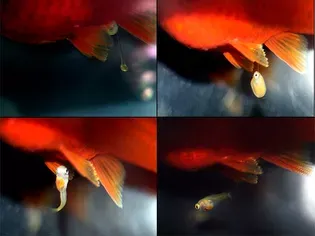Live-Bearer Development Period Inside Female and as Fry
Updated on 05/26/24

Unveiling the Enigmatic Journey of Live-Bearer Reproduction: From Womb to Independence
In the captivating realm of biology, live-bearer species stand out as unique marvels of nature, showcasing an intricate reproductive strategy that involves carrying developing embryos within the mother's body until they are fully formed and ready to embark on their independent lives. This remarkable process, known as viviparity, captivates scientists and nature enthusiasts alike, offering insights into the astonishing diversity of life on Earth.
This comprehensive blog delves into the captivating world of live-bearer development, exploring the intricate processes that unfold within the female's body and the subsequent journey of the emerging fry. Through a blend of scientific knowledge, intriguing examples, and practical guidance, we will unravel the mysteries surrounding live-bearer reproduction, empowering you with a profound understanding of this fascinating phenomenon.
Part 1: The Nurturing Womb: A Safe Haven for Developing Embryos
1.1 Gestation Period: A Time of Transformation and Growth
The gestation period, a crucial phase in the live-bearer reproductive cycle, marks the remarkable transformation of fertilized eggs into fully developed fry. The duration of gestation varies significantly among live-bearer species, ranging from a few weeks to several months. During this period, the embryos reside within the mother's body, enveloped in a protective environment that provides sustenance and safeguards their delicate development.
1.2 Placental Connection: A Lifeline for Nourishment
The placenta, a vital organ that forms during gestation, plays a pivotal role in sustaining the developing embryos. This temporary structure establishes a direct connection between the mother's circulatory system and the embryos, allowing for the efficient exchange of nutrients and oxygen. The placenta also serves as a vital conduit for the removal of waste products, ensuring a healthy and conducive environment for embryo development.
1.3 Maternal Care: Nurturing the Unborn
Live-bearer mothers exhibit remarkable adaptations that facilitate the well-being of their developing offspring. Specialized structures, such as the brood pouch in some fish species, provide a secure and sheltered environment for the embryos. Additionally, the mother's body may undergo physiological changes to accommodate the growing embryos, ensuring an optimal environment for their development.
Part 2: The Birth of Live-Bearer Fry: A Triumphant Emergence
2.1 The Miracle of Live Birth
The culmination of the gestation period is marked by the birth of live-bearer fry, a moment of triumph and transition. Unlike egg-laying species, live-bearers give birth to fully formed offspring, eliminating the need for an external hatching process. The fry emerge from the mother's body, equipped with the necessary adaptations to embark on their independent journey.
2.2 Size and Development at Birth
The size and level of development of live-bearer fry at birth vary depending on the species. Some species give birth to relatively small and underdeveloped fry, which require additional care and protection from the mother or other adults. In contrast, other species produce larger and more developed fry, capable of fending for themselves soon after birth.
2.3 Parental Care: Ensuring Survival and Growth
In certain live-bearer species, parental care extends beyond the birth of the fry. Some mothers exhibit protective behaviors, such as guarding the fry from predators and providing them with shelter. Additionally, some species may engage in parental feeding, ensuring the nourishment and survival of their offspring during their early stages of development.
Part 3: Essential Considerations for Live-Bearer Care
3.1 Aquarium Setup: Creating an Optimal Environment
Providing a suitable aquarium environment is crucial for the health and well-being of live-bearer species. The size of the aquarium should be appropriate for the number and size of the live-bearers, and the water conditions should be carefully monitored to ensure optimal parameters. Live-bearers typically thrive in well-oxygenated water with a stable pH level and temperature range.
3.2 Diet and Nutrition: Fueling Growth and Development
Live-bearers exhibit diverse dietary needs depending on their species. Some species are omnivorous, consuming a wide range of plant and animal matter, while others have more specialized diets. Providing a balanced and nutritious diet that meets the specific requirements of your live-bearers is essential for their optimal growth and development.
3.3 Breeding: Nurturing the Next Generation
Understanding the reproductive behavior of your live-bearer species is crucial for successful breeding. Some live-bearers are highly prolific, producing numerous offspring throughout their lifespan, while others may have more restricted reproductive cycles. Researching the specific breeding requirements of your live-bearers will help you create the optimal conditions for successful mating and offspring production.
Conclusion
The world of live-bearer reproduction is a captivating tapestry of biological wonders, showcasing the remarkable diversity and ingenuity of nature. From the nurturing environment of the mother's body to the triumphant emergence of live-bearer fry, this reproductive strategy offers a profound glimpse into the complexities and marvels of life on Earth.
Whether you are a seasoned aquarist, a budding nature enthusiast, or simply curious about the intricate world of biology, we hope this comprehensive guide has enlightened you on the captivating journey of live-bearer development. By understanding the intricacies of this remarkable process, we can appreciate the beauty of nature and contribute to the well-being of these fascinating creatures.
Explore More Pets

Freshwater Aquarium Filters
How to Deal With Cloudy Aquarium Water

Saltwater Aquarium Filters
How Do You Remove Chloramines From Tap Water?

Freshwater Aquariums & Habitat
Can I Keep My Koi Fish Inside?

Saltwater Aquariums & Habitat
14 Best Floating Plants for Your Aquarium

Freshwater Fish Health
How to Treat Ich on Freshwater Fish

Saltwater Fish Health
Fin Rot in Aquarium Fish

Freshwater Aquarium Filters
How to Do Aquarium Water Changes

Saltwater Fish Health
How Do Fish Get Parasites?
